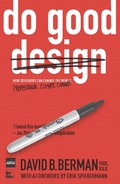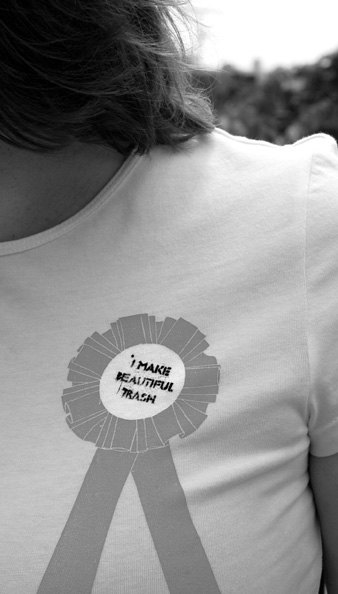
Designers around the world are recognizing their power and their responsibility
“Thuoghts are mightier than armies. Principes have achieved more victories than horsemen or chariots.” | ||
| --WILLIAM MILLER PAXTON (1824-1904) | ||
SPRINKLED THROUGHOUT this book are stories of individuals from the design world making a difference to the whole world. Why not you too?
There is no reason why you cannot also make an extraordinary mark in our world. You simply have to decide to do it. You don’t need to be the greatest designer that ever lived: I am certainly no all-star, and neither are most of the individuals whose contributions I celebrate in this book (sorry, pals!).
Einstein’s brain may have been a bit larger than most, and Michael Jordan is certainly taller, however most people who have left the world an exceptional legacy are people just like you who simply decided to do the extraordinary. If, like most people, you need some kind of green light or permission to behave in an extraordinary way, I am hereby giving you permission to be extraordinary.
Organizational change is also afoot in our industry: each time, it starts with one person. This chapter highlights many hopeful steps that professional groups are taking as the worldwide momentum of doing good takes hold.

On display at MOMA New York, paraSITE by Michael Rakowitz: transportable homeless shelter, made from discarded materials, inflated by neighborly outtake ducts.
The idea that designers’ talents should be directed beyond selling stuff is not new: in 1964, Ken Garland released the First Things First manifesto in London, signed by 22 concerned designers.
In 2005, during our tour of downtown London, Ken’s wife Wanda showed me the McDonald’s that used to be London’s city hall: it dawned on me that poor countries are not the only ones at risk of having their cultures ground up and loaded with filler.
For me, Ken exemplifies the designer who is both ordinary and extraordinary. That evening, over tea in Ken’s Camden home-studio, he reminisced that he wasn’t suggesting we should have any less fun; he simply thought that our skills could be used in much nobler ways.

See Appendix A to read the entire manifes to
In 1983, the world bodies of the main design disciplines (Icograda, IFI, and icsid)[124] jointly declared that “a designer accepts professional responsibility to act in the best interest of ecology and of the natural environment.”
In the year 2000, the Society of Graphic Designers of Canada adopted a courageous and progressive national code of ethics, standing on the shoulders of many inspiring documents from around the world. I’m proud to say that our resulting code went further than any other professional code that we were aware of: it established, by definition, that professionalism includes a commitment to social and environmental responsibility.
Icograda, the world body for communication design, offers the Canadian model as a benchmark for design associations in other countries seeking to establish their own codes of conduct.
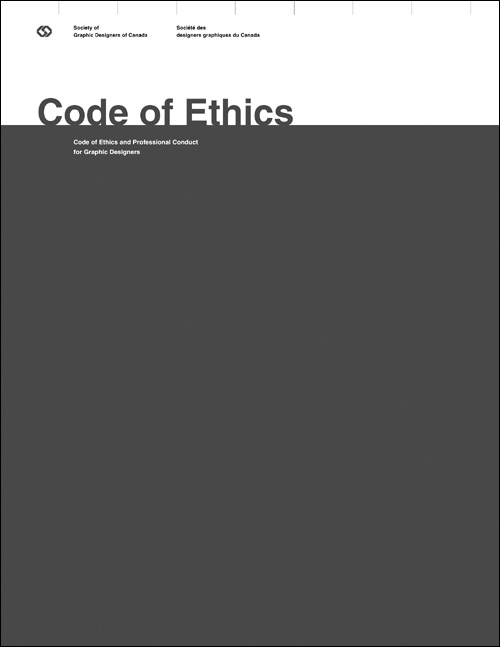
See Appendix B to read highlights of the Canadian code
In 2005, AIGA, the world’s largest national association of designers, adopted our language when republishing its own professional standards, then in 2008 translated it for use in design education in China. Also in 2008, Norway adapted the Canadian policy to serve as its first code of ethics for Norwegian graphic designers and illustrators.
Meanwhile, design associations around the world have been injecting environmental and social responsibility into their codes, from Ukraine to Australia to Israel to Brazil.
Since 1996, in my home province of Ontario, Canada, graphic design has been a certified profession – in no small part due to the heroic efforts of one Toronto designer named Albert Ng. The term “R.G.D.” (and “Registered Graphic Designer”) is now a professional designation protected by law, just like “registered nurse” or “medical doctor” or “lawyer.” This was a first in the Americas and second in the world.
To receive this title, you must pass an examination, a quarter of which evaluates knowledge of professional conduct standards. Designers from across Canada worked diligently to get the certification in place. The curriculum of Ontario design schools has been adjusted to prepare graduates to pass that exam.
As the president of the first elected board of this association, I worked hard to craft bylaws that include a professional commitment to society and the environment. The Rules of Professional Conduct are linked through certification to the law of Ontario: designers can lose their designation through a formal grievance procedure that any citizen can initiate.

Certification is a force of good that is not exclusionary. It doesn’t stop anyone from designing. It doesn’t limit creativity. But it does recognize the fundamental role that designers now hold within society. And it’s a huge step towards our society recognizing that not just anyone should be entrusted with crafting critical visual messaging.
Certification does not guarantee that a design buyer will get an all-star designer. It does establish a minimum standard: those who hire designers get a person bound to a minimum level of performance with respect to business procedures, education, skill, and ethical behavior. Certification helps protect society from the damages of predatory persuasion and exploitative design; much the same way that certification of architects protects against buildings that could fall down on them.
Ontario is not unique: there is also a form of graphic design certification in Switzerland. And in 2008, Norway adopted their own form of certification for graphic designers. Meanwhile, Canadian designers outside Ontario continue to explore adoption of the construct in other provinces.
I’ve lectured on certification in the United States, Hungary, the Czech Republic, and Colombia because I believe strongly that certification is part of the solution: if you need help making it happen where you live, we can work together to get it done.
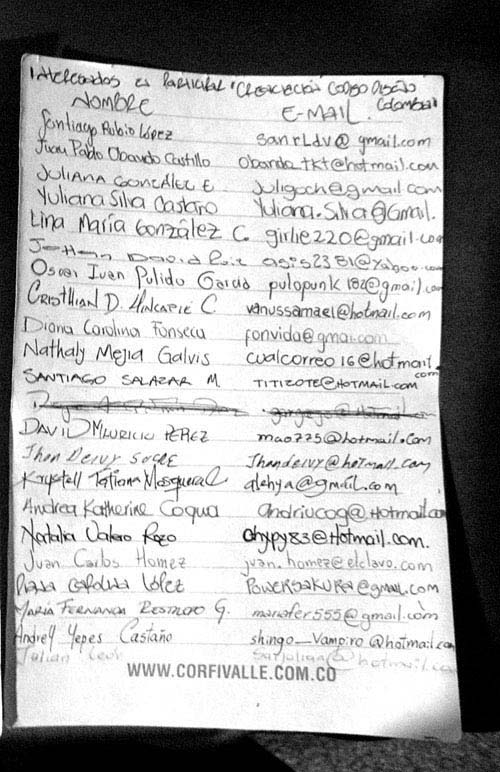
Colombian students volunteered to work towards certification for designers in their country
In 1999, activating the brainchild of Japanese designer Kenji Ekuan, the world bodies for the main design disciplines (graphic design, industrial design, and interior design) birthed Design for the World, a joint organization dedicated to global social responsibility, in conjunction with the Barcelona Design Center. Here’s the idea: Meet with the global nongovernment organizations working in the front lines of need (UN High Commission for Refugees, International Red Cross, Médecins Sans Frontières, etc.) to determine how design can help those in greatest need. Then match up volunteer designers to craft solutions, funded by corporations that have agreed to fulfill their social responsibility mandates this way. It remains to fulfill its potential.
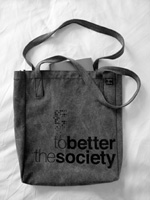
Rethinking: Hong Kong Design Centre held a social responsibiity themed design week, right down to the cotton bags. Cirque du Soleil chops up used tents, using local labor to make shoulder bags.
Designers must educate the public that design is about strategy, not decoration. However, such attempts are repeatedly undermined by a design world hooked on competitions and awards ceremonies that celebrate creativity instead of strategy results and sustainability.
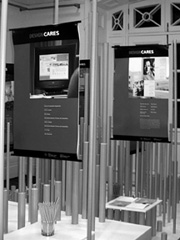
Design Cares exhibit in Hong Kong

Inequality Matters exhibit in Beijing
A little bored during a national GDC board meeting in Nova Scotia, Victoria’s Peggy Cady and I started to brainstorm: how about a design competition that celebrates the best results to the community, rather than the best creativity or technical skill? I’ve only known Peggy as a person of action. Within a year, the Victoria chapter of the Graphic Designers of Canada had produced the Design Cares competition. I was to speak at the opening of the exhibit, and was awestruck immediately when entering the room. Members of the public and media from the city of Victoria, British Columbia, wandered from exhibit to exhibit, immersed in a how design was doing good in their community: in their hospitals, in their streets, in their water, in their air. Design mattered. Unmistakably. The event was so popular that it resulted in a traveling exhibition that has toured four continents.
Another example of a design show that matters, the massive Inequality Matters posters illustrate how much disparity there is in the world regarding the human condition. The original series was designed by Tom Geismar through AIGA for the 2005 World Summit, the largest gathering of the world’s leaders to date.
And in Icograda, we have recently developed global policy for greener events, to help designers lead by example.
“Good design enables, bad design disables.” So declares the 2004 Stockholm Declaration of EIDD – Design For All Europe, which has chapters in twenty countries. EIDD is dedicated to how design can improve life while leaving no one behind. Sweden’s Finn Petrén, EIDD’s president, explained to me that being “accessible” is not enough: that term suggests that material is simply available to all. EIDD demands design that at a minimum enables an equivalently immersive and convenient experience for all, regard-less of age, culture, or ability. They lobby all levels of government, professionals, and businesses.
“Everyone has the right freely to participate in the cultural life of the community, to enjoy the arts and to share in scientific advancement and its benefits.” | ||
| --ARTICLE 27.1, UNIVERSAL DECLARATION OF HUMAN RIGHTS, 1948 | ||
Truly inclusive design isn’t just a moral imperative. The majority of humans, at one point in their lives, will have some significant disability. Thus, from information technology to packaging to tourism, designing for all is not just kind, it’s good business.
As I mentioned earlier, it was fairly early on in the Internet’s development that accessibility was recognized as a driver. The World Wide Web Consortium, housed at MIT and led by Sir Tim Berners-Lee, the father of the Web, has recently put the finishing touches on the 2.0 release of its Web Content Accessibility Guidelines. Accessibility has been a Web priority since the 1990s, with the realization of how liberating the Internet would be for the hundreds of millions of people worldwide who have disabilities or deficits.
Canada’s federal government leads the world in the speed and depth to which it embraced an accessible Web experience for its audience: something I’ve been very proud to be a part of. Simply put, Web pages that are not accessible for people with disabilities and difficulties are not allowed to be posted anywhere in the federal government’s Web presence. This policy has been in effect since 2002.
Design critic Max Bruinsma believes that writers and designers are akin, in that both organize interfaces between content and form. “Designers are cultural agents,” he explained over midnight grappa at Turin’s Design Week. I asked him, out of all the design literature he has worked with throughout his career, what is he most proud of? He said that without a doubt it was working with Kalle Lasn and Rick Poynor on the rerelease of the First Things First manifesto, when he was editor of Eye magazine. Nine years later he stills gets a substantial amount of e-mail about First Things First 2000. Adbusters magazine led the charge to release a year 2000 version of the First Things First manifesto, this time signed by designers from around the world, including Ken. It was jointly published in Adbusters, the AIGA Journal, Blueprint, Émigré, Eye, Form, and Items. Kalle reflected to me recently that “in 2000, the world still looked fairly benign. Since then the triple punch of psychological, geopolitical, and environ-mental upheaval is causing designers to wake up.”
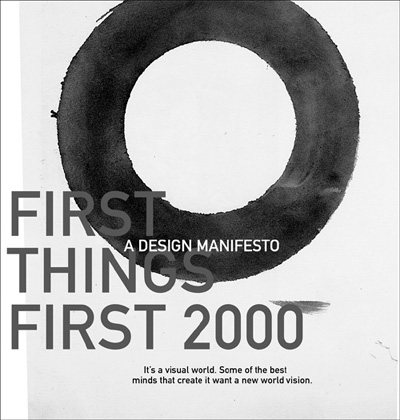
The rereleased manifesto calls out “in expectation that no more decades will pass before it is taken to heart.” Another decade has almost passed: now is our time to take up its call.
Waiting for change can be painful; however, when change does come, it often arrives with shocking speed. It took less than 15 years for the use of recycled paper to become the norm, rather than the exception. Ninety percent of Europe’s top companies now publish corporate social responsibility reports (and the majority of the top 100 U.S. companies do, too).[125] And after years of frustratingly slow adoption, today, being green has become a mainstream obsession.

This postcard is distributed at events where the Dalai Lama speaks in Canada
For many people who want to challenge the existing system, the only choices are to protest injustice or work outside the system. But with the persuasive power and opportunities of a professional communicator, you can likely have a far greater and more lasting impact by changing the system from within.
It is clear that the change we need has already started to take place, on every continent.
“But what can I do right now?” you may ask. Well, for starters, you can turn the page.


Have a personal mission. Rethink. Know what you need, then seek out products that will fit you for a long time. Read Cradle To Cradle. Demand objects that are designed to last. Avoid disposables. Carry one great pen. Carry chopsticks. Carry your own shopping bag. Carry a tune. Be happy with your hair. Give ideas as presents more often, things less. Give a gift subscription to Adbusters. Eat less junk. Eat fewer animals. Avoid bottled water. Drink local beer. Seek simple entertainment. Have fun. Remember that you are already beautiful (and embrace those who have told you so). Avoid style magazines: fashion is declawed rebellion, and a weak substitute at that. Entertain yourself simply. Don’t leave your car idling (except in Wasilla). If you don’t have democracy, fight for it. If you do have democracy, fight to keep it. Then vote for lawmakers who will make laws that control visual lies and will regulate products that steal dreams. Shake off the excessive amount of stuff you have in your life, then see how much lighter you feel. Plan more carefully, so you can consume more efficiently. Resist all messages that seek to convince you that you need to consume in order to feel good. If shopping is your hobby, find a more sustainable hobby. If shopping is your habit, figure out why. Avoid products made of PVC, the hazardous waste of the display industry. Buy products that tell the truth. Resist designer products unless you see the value the designer has contributed. Resist being manipulated by visual lies. Resist giving up your mental environment to corporations that wish to post billboards in your mind. Don’t get too comfy. Stay alert. Demand truth. Share your truth. Speak out when you see visual lies. Think about how you can apply the principles in this book to all professions. Lead by example. Teach it. Live it. Share it. Design your better future, then help us all design ours.
“Be the change you want to see in the world.” | ||
| --MAHATMA GANDHI (1869-1948) | ||
